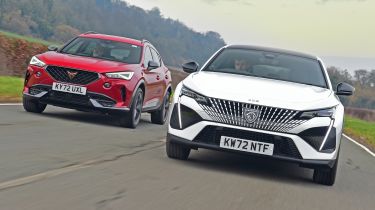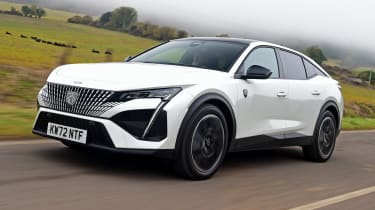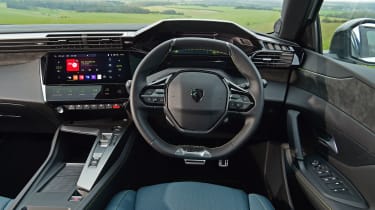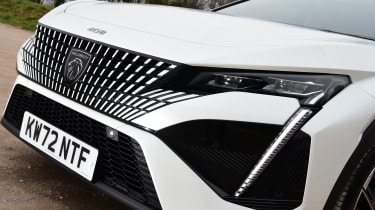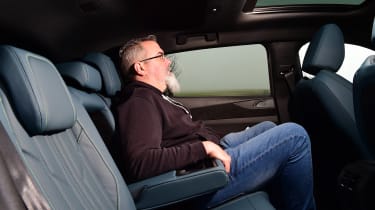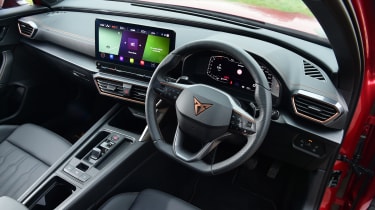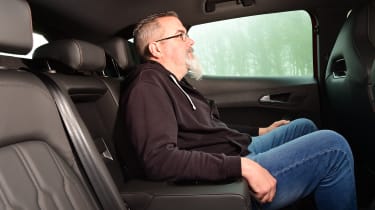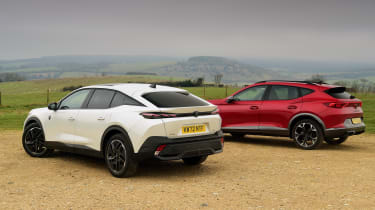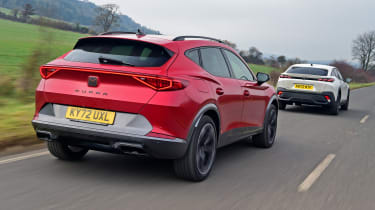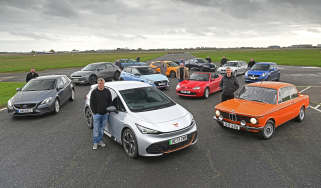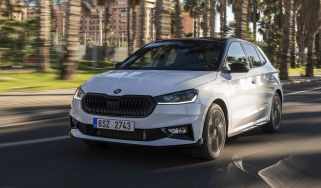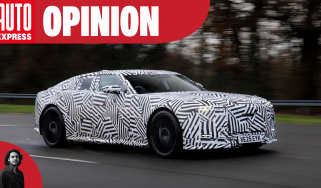Peugeot 408 vs Cupra Formentor: 2023 twin test review
The swoopy new Peugeot 408 locks horns with Cupra's Formentor crossover
Not everybody wants an SUV, but in a world where high-riding family cars are pretty much the norm, there aren’t many alternatives available to buyers looking for something that isn’t quite so chunky. However, it’s a situation that Peugeot is aiming to rectify with the new 408.
It still has an SUV-style ride height, but it features swoopier bodywork that is more like a coupe in execution, and slots between the 308 and 508 in terms of size and price.
One SUV that is closer to this crossover philosophy than many is the Cupra Formentor. But which model manages to combine style and practicality the best?
| Peugeot 408 | Cupra Formentor | |
| Price: | £34,650 | £33,825 |
| Powertrain: | 1.2-litre 3cyl turbo petrol, eight-speed auto, fwd |
1.5-litre 4cyl turbo petrol, seven-speed auto, fwd |
| 0-62mph: | 10.4 seconds | 8.9 seconds |
| Test economy: | 40.3mpg/8.9mpl | 39.6mpg/8.7mpl |
| CO2: | 136g/km | 155g/km |
| Annual VED: | £165 | £165 |
Peugeot 408
The new Peugeot 408 isn’t a replacement for another model. Instead, it carves a new niche as a five-door coupe-crossover that slots somewhere between the 308 hatch, 508 saloon and possibly even the 3008 SUV. Here we’re testing the top-spec GT trim, but with the smallest engine in the line-up, a 1.2-litre petrol unit, while our car comes in at £39,275 including options.
Tech highlights
The big talking point of the 408 is its dramatic bodywork. With its long bonnet, low roof and tapering rear end, it has quite a distinctive five-door coupe shape, but this sporty appearance is offset by its raised ride height. It’s not as jacked up as an SUV, but there’s more ground clearance here than under a 508, while the relatively skinny tyres mean Peugeot’s newcomer looks like it’s on stilts when compared with the Formentor here.
Beneath the body, the 408 shares its running gear with the latest Peugeot 308 hatchback, so it uses the third-generation version of Stellantis’s EMP2 platform. There’s MacPherson-strut front suspension and a twist-beam rear axle, which is a less sophisticated set-up than the multi-link rear end that all versions of the Formentor use.
Used - available now

2020 Jaguar
F-Pace
64,751 milesManualDiesel2.0L
Cash £11,936Powertrains match what’s in the 308 line-up, too, and here the 408 is powered by Stellantis’s ubiquitous 1.2-litre PureTech three-cylinder turbocharged petrol engine. As with the 308, all versions of the 408 feature an EAT8 eight- speed automatic gearbox and front-wheel drive.
Safety: While the 408 hasn’t been tested by Euro NCAP, it shares technology with the latest 308, so that car’s score should be a good reflection of the 408’s safety credentials. In 2022 it earned five stars and high percentage scores across the board, although the Formentor scored higher in 2021.
On the road
While it has the look of a rakish coupe, the 408 errs on the side of comfort rather than sportiness.
Around town: You might expect the 408’s raised suspension to deliver a comfortable ride, but at low speeds it feels harsher than the Cupra. There’s a brittleness to the ride that never resolves itself, while bumps and cat’s eyes aren’t ironed out too effectively. The 1.2-litre engine is largely fine as long as you don’t rush it, but a power deficit when compared with the Formentor means it’s not the most responsive from a standstill.
A & B-roads: Increase your pace and things improve. The 408’s suspension copes better the faster you go, with a supple ride shrugging off bigger bumps well. However, tackle a series of tight corners, and the 408’s soft ride means there’s more lean in corners than in the Formentor, and while the small steering wheel gives the car a sporty edge, there’s not much feedback. The narrow, energy-efficient tyres also deliver less grip than the Formentor’s wider rubber.
The 1.2-litre engine delivers a sporty note, but it’s held back by the auto gearbox. It doesn’t like to be hurried when moving between ratios, with a distinct pause between upshifts and hesitation when kicking down a gear or two. Sport mode sharpens things up with a snappier response, but the Cupra has an edge for entertaining handling.
Motorway: It’s here where the 408 performs at its best. There’s plenty of three-cylinder thrum as you accelerate up to motorway speeds, but once the auto box gets into top gear and you’re cruising, everything quietens down. There’s hardly any wind noise or tyre roar, and the car’s pliant ride means that the 408 is quite relaxing at higher speeds.
Ownership
Peugeot’s march towards more premium-feeling machinery hits new levels with the 408.
As well as being pitched as a more sophisticated alternative to a 308 or 508, it has a design-led cabin that’s meant to appeal to style-conscious buyers.
Quality inside is great, with soft-touch plastics and distinctive lime-green stitching signifying our car’s GT spec; these colours are replicated in the cabin lighting on the doors, too.
The centre console features a toggle-style drive selector that looks classy, although it’s now standard issue on any auto-equipped Stellantis model, from its electric vans to the Vauxhall Astra. But you’re unlikely to feel short-changed by its ambience if you never sit in anything other than a 408.
The centre console comes equipped with Peugeot’s i-Connect Advanced touchscreen, which features shortcut buttons and a bank of toggle switches below the main panel. This is a decent system, but the 408’s dashboard layout sets the display back from the front seats, so if you’re taller, you may need to lean forward to use the touchscreen, or activate the voice-control system.
Our car also came with optional £2,300 leather trim finished in Naboo Blue, which really helps to give the cabin a lift. You can get black leather for the same price, too, but the blue suits the 408’s design-led philosophy well.
I-Cockpit: One aspect that could make or break a potential 408 sale will be Peugeot’s i-Cockpit dashboard. It’s familiar from other models, with the dials positioned above the small steering wheel, supposedly so that your eyes are taken off the road for less time. It means you have to lower the small wheel into your lap to see the 408’s flashy 3D dials properly, but while this can be awkward for some drivers, the only thing that’s obscured in this configuration is Peugeot lettering and a stylised French tricolore.
Rear screen: Aesthetics dictate that the 408 does without a rear wiper, so Peugeot has added aerodynamic aids to the trailing edge of the roof to help keep the screen clear. They work on the move, but aren’t much use if the glass gets dirty while the car is parked
Design
Slats across dashboard link the air vents together, but large expanse of plastic beneath cuts into front passenger space
Storage: Armrest cubby is deep, while the slot ahead is wide enough to take a smartphone; the charging ports are ahead of the cup-holders, though.
Clever 3D dials add an upmarket touch to Peugeot’s i-Cockpit system, and the layout is widely configurable. The AGR label stands for Aktion Gesunder Rücken, or Campaign for Healthier Backs, a German health initiative.
Drive mode selector scrolls through Eco, Normal and Sport modes, with the latter improving the throttle response
Practicality
That low roof doesn’t cut into headroom as badly as you might expect, while cabin storage is decent, with carpeted door bins and a large glovebox at your disposal.
Rear Space: Access to the back seats is reasonable because the doors open wide, but that low roof does get in the way a little. Once in, there’s more shoulder room than in the Formentor, but less headroom. The darkness of the tinted windows and black plastics was offset by the blue leather of our test car.
Boot: The tailgate opens to reveal a boot that measures 536 litres, which is 86 litres up on the Cupra’s cargo area. There’s a lower load lip, too, while levers in the sides of the boot help to fold the 60:40-split seats and create 1,611 litres of space.
A small cargo hatch is fitted to the backrest if you need to fit longer items while still carrying passengers.
What to buy?
Which engine and trim we’d choose
- Engines: There’s the 1.2 PureTech 130 driven here, plus two Hybrids, a 180 and a 225. These use a 1.6-litre four-cylinder petrol in two states of tune and a 109bhp electric motor and 12.4kWh battery set-up for up to 40 miles of EV range.
- Trim: The 408 line-up is comprised of Allure, Allure Premium and GT trims, with a price walk of £1,125 and £2,475 between them. The Hybrid 225 powertrain isn’t offered in Allure spec.
- Options: Only GT trim offers options other than paint, with the highlights including a panoramic sunroof (£900).
- Our choice: GT spec offers the full 408 experience, and we’d choose the 1.2 petrol turbo
Cupra Formentor
The Cupra Formentor arrived in 2020 as the sporty Spanish brand’s first standalone model that wasn’t originally marketed as a SEAT. Here we’re testing one of the more mainstream variants
in the line-up, a V2-spec version with a 1.5 TSI turbocharged four-cylinder petrol engine. Options push the price of our test car up to £35,230, which is only slightly more than the standard 408 GT.
Tech highlights
When the Cupra Formentor was first released, its racy bodywork offered a sportier look than anything else in the Volkswagen Group’s compact SUV line-up. It’s more upright than the Peugeot 408 here, but it still has a sense of purpose about it, with a long bonnet leading into a low-set passenger compartment featuring creases and curves that add some muscle to its shape. The inclusion of gloss-black roof rails means the Formentor still has an SUV-like appearance, too, although they don’t detract from its sporting intent.
That sporty body is draped over the VW Group’s MQB Evo platform, which is used by a number of other models across the group. The Formentor is fitted with MacPherson-strut front suspension and a multi-link rear axle, which allows Cupra to add four-wheel drive to higher-spec variants. Here, the 1.5 TSI is front-wheel drive only, but has the option of six-speed manual or seven-speed twin-clutch DSG automatic gearboxes.
Safety: If you carry more than one youngster in your car, then the Cupra has more options than the Peugeot for fitting child seats. As well as Isofix child-seat attachments on the outer rear seats, it also has them on the front passenger seat. The Formentor has larger doors, too, so it’s easier to install a child seat. Both cars feature passenger airbag deactivation, though.
On the road
Cupra’s sporting credentials are intact here, but they’re boosted by a big slice of everyday usability.
Around town: A low-set driving position offers a feeling of sportiness in the Formentor, but it also means that visibility could be a bit better. The bonnet rises and falls ahead of you – in some ways giving the feeling of a classic front-engined sports car – while the narrow side windows and thick C-pillars also hinder things, although visibility is no worse here than it is in the Peugeot.
A & B-roads: Both the 408 GT and Formentor V2 come with 19-inch alloy wheels, but the Cupra’s wider tyres mean it has more grip. Combine this with the multi-link rear suspension set-up, more direct steering and an electronic diff lock, and the Formentor is the car that delivers the most entertaining drive here. That low-set seating position adds to that feeling of sportiness, too.
The only disappointment is a shortage of power from the 1.5-litre engine. While the Formentor packs 19bhp more than the 408, is faster from 0-62mph (a time of 8.9 seconds is 1.5 seconds ahead of its rival here) and the gearbox is sharper to respond in auto mode, it’s obvious that the chassis can easily cope with more power.
Drive Profile settings offer an Individual mode to tailor the car to your liking, although without adaptive dampers available on any version of the Formentor, there’s not much point in switching from the Normal or Sport modes.
Motorway: Cruising at 70mph is relatively relaxing in the Formentor, although there’s more road and wind noise than in the Peugeot. Adaptive cruise control comes as standard, and works well in the flow of motorway traffic.
Ownership
If a coupe-SUV or crossover is meant to deliver a level of sportiness that is unattainable by a conventional compact SUV, then the Cupra Formentor delivers the goods. The flat-bottomed steering wheel looks the part, and its perforated- leather rim feels good to hold, while the cowled Virtual Cockpit dials and copper detailing used throughout add to the sporty feel.
Another highlight are the sports seats fitted up front. They’re trimmed in Nappa leather and feature headrests that are integrated into the body of the seat, in true performance-car style. Despite this, they’re a normal width, so getting in and out of them is no harder than with regular seats. There’s a more upright dashboard in the Formentor, too, which means it doesn’t encroach on passenger legroom as much as the 408’s layout does.
Build quality throughout is decent, but a little behind the Peugeot for the standard of materials in places. Take the door bins, for example; they’re not as deep as the Peugeot’s and aren’t flock- lined, plus they’re tricky to access, courtesy of the thick armrests above. However, this latter criticism can also be levelled at the 408.
If something goes wrong with either car, they’re covered by a three-year, 60,000-mile warranty.
Driver Power: Neither of these cars has yet been included up in our Driver Power ownership survey, while Cupra is too new to have made an appearance in the manufacturer rankings, either. It has close ties with SEAT – its franchises either sell or service Cupra models – but owners aren’t that impressed with that company’s performance when compared with Peugeot’s.
The French firm isn’t just moving upmarket with the quality of its cars, but is also backing this up with improved customer service. A third place for its dealers in our 2022 survey is all the evidence you need of the company’s progress in this area.
Practicality
A more upright body compensates for the Cupra’s smaller external dimensions.
Rear Space: There’s not much between these two for rear-seat space, and what the Formentor gives away in terms of shoulder and legroom, it makes up for with more headroom. Larger rear windows mean it doesn’t feel as tight in the back of the Cupra as it does in the 408, either.
Standard-fit three-zone climate control means there are vents and a temperature slider in the back of the Formentor, while twin USB-C sockets are fitted, too.
Boot: There’s a slightly higher load lip in the Cupra, but the threshold isn’t as wide as the 408’s, so it’s actually easier to load items here without hitting the boot lip. Perhaps Peugeot is expecting owners to struggle with this, because the 408’s load lip is finished in scratch-resistant black plastic.
Controls: Touch-sensitive sliding bars below main screen operate climate and volume, but are frustrating. Figures for cabin temperature are located high in the touchscreen, while the bar itself isn’t illuminated at night.
What to buy?
Which engine and trim we’d choose
Engines: There’s more variety for the Formentor, with a 1.5 TSI 150, a 2.0 TSI in 190, 245 and 310 guises (the latter with four-wheel drive), while a 1.4 TSI Hybrid is offered in 204 and 245 variants. All are auto-only, except for the 1.5 TSI.
Trims: V1 and V2 trims feature the 1.5 TSI 150, 2.0 TSI 190 and 1.4 Hybrid 204 engines, VZ1 has the 245 versions of the 2.0 TSI and Hybrid, VZ2 also adds the 2.0 TSI 310, while the VZ3 only uses this unit.
Options: A panoramic roof, tow bar and hands-free powered tailgate are offered, while a safety pack is available on V2 cars.
Our choice: This V2 model is well specced, but we’d swap the 1.5 TSI for the 2.0 TSI 190.
Results
Which car comes out on top?
Winner: Cupra Formentor
These two models are closely matched in terms of practicality and running costs, but the Cupra edges ahead courtesy of a more focused drive that doesn’t compromise on everyday usability.
There’s a long kit list for a lower list price than on the Peugeot, too, although this version of the Formentor also has its faults. The touchscreen can be frustrating, while the 1.5 TSI petrol isn’t the powerplant that we’d choose because it’s a bit too sluggish to do justice to the car’s chassis.
| Pros | Cons |
| Sporty handling | Frustrating infotainment |
| Well equipped | Adequate power |
| Good interior space | Rearward visibility |
| Sharp looks | Low seat for some |
Runner up: Peugeot 408
The 408 is certainly a head-turning family car, and it’s not compromised in terms of practicality, either. The quality of the interior is first rate, too, thanks to the soft-touch materials and sharp-looking screens, while there’s more boot space here than in the Cupra.
We just wish it delivered a sportier driving experience to go with its coupe looks, because it lacks the grip of the Cupra, while the petrol engine and auto gearbox combination delivers sluggish responses.
| Pros | Cons |
| Sharp looks | Tight rear access |
| Stylish interior | Firm ride at low speeds |
| Cruising comfort | Sluggish gearbox |
| Soft ride | Driving position |
Rivals and other options
- Same class: Renault Arkana
- Same money: Ford Puma ST
- Used: Audi Q3
- Used: Porsche Macan
- Coming soon: Toyota C-HR
The great debate
What the Auto Express test team would do…
Sean Carson, associate editor: “If you can’t wait for the all-new Toyota C-HR, then the current car is still well worth a look. Its balance of ride and handling is better than the 408’s, and whether you go for the 1.8 or the 2.0-litre hybrid, it returns superb fuel efficiency, too. But the back seats are cramped.”
John McIlroy, deputy editor: “I can't deny that Peugeot has made a really appealing car with the 408, it’s just that it can’t quite compete with the very strong finance deals for the Cupra. The Formentor is something of a bargain not only beside the 408, but also by the standards of the family-car segment as a whole.”
Alex Ingram, chief reviewer: “The biggest issues all centre around the 408’s powertrains. The PHEV is just okay, and the petrol’s gearbox calibration is frustrating. An all-electric powertrain would solve the Peugeot’s biggest flaws, and the good news is that one will be joining the range soon. I reckon it will be the one to have.”
Steve Fowler, editor-in-chief: “We've got the baby powerplants in each of these two contenders for this contest. While both models also come with PHEV options, the Cupra’s range has more depth courtesy of a hot range-topper with 306bhp and hot-hatch acceleration figures. It’s great to drive, too.”
Jordan Katsianis, senior staff writer: “Put aside the odd niche the 408 is squeezed into, it’s worth thinking about the price premium you’re paying. The 308 has less rear legroom and boot space but is mechanically the same, and in GT trim on a three-year PCP deal, it’s £67 per month cheaper.”
What would you do? Let us know in the comments section below…
Specs and prices
| Peugeot 408 1.2 PureTech EAT8 GT | Cupra Formentor 1.5 TSI DSG V2 | |
| Petrol or diesel? | Petrol | Petrol |
| MPG | 40.3 | 39.6 |
| Fuel price (£) | £1.48 | £1.48 |
| P11D value | £34,365 | £33,185 |
| Fill up | £76.85 | £73.90 |
| On the road price/total as tested | £34,650 / £39,725 | £33,825 / £35,320 |
| Residual value (after 3yrs/36,000) | £17,706 (51.1%) | £19,991 (59.1%) |
| Depreciation | £16,944 | £13,384 |
| Annual tax liability std/higher rate | £2,199.36 / £4,298.70 | £2,389.32 / £4,778.60 |
| Annual fuel cost (10k/20k miles) | £1,667 (£3,334) | £1,697 (£3,393) |
| Ins. group/quote/VED | 21 / £605 / £165 | 20 / £543 / £165 |
| Service costs (3 years) | £648 | N/A |
| Length/wheelbase | 4,687 / 2,787mm | 4,450 / 2,680mm |
| Height/width | 1,478 / 1,859mm | 1,528 / 1,839mm |
| Engine | 3cyl in-line / 1,199cc | 4cyl in-line / 1,498cc |
| Peak power/revs | 129bhp / 5,500rpm | 148bhp / 5,000rpm |
| Peak torque/revs | 230Nm / 1,750rpm | 250Nm / 1,500rpm |
| Transmission | 8spd auto / fwd | 7spd auto /f wd |
| Fuel tank capacity/spare wheel | 52 litres / repair kit | 50 litres / £125 |
| Boot capacity (seats up/down) | 536 / 1,611 litres | 450 / 1,475 litres |
| Kerbweight | 1,392 / 528 / 1,200kg | 1,458 / 522 / 1,800kg |
| Turning circle | 11.2 metres | 11.4 metres |
| Basic warranty/recovery | 3yrs (60,000) / 1yr | 3yrs (60,000) / 2yrs |
| Driver Power manufacturer position | 4th / 3rd | 17th (SEAT) / N/A |
| Euro NCAP: Adult/child/ped./assist/stars | N/A | 93/88/68/80/5 (2021) |
| 0-62mph/top speed | 10.4 seconds / 130mph | 8.9 seconds / 126mph |
| Auto Express economy/range | 40.3 / 461 | 39.6 / 436 |
| WLTP combined | 48.1 | 42.2 |
| WLTP combined | 10.6 | 9.3 |
| Actual/claimed CO2 | 162 / 136g/km | 165 / 155g/km |
| Number of airbags/Isofix points | Six/two | Six/three |
| Parking sensors/camera | Front & rear/yes | Front & rear/yes |
| Lane-keep assist/blindspot/AEB | Yes/yes/yes | Yes/£620/yes |
| Climate control/adaptive cruise | Two-zone/yes | Three-zone/yes |
| Leather/heated seats/wheel | Part faux/£1,100*/yes | Yes/yes/yes |
| Metallic paint/LED lights | £725/yes | From £595/yes |
| Keyless entry & go/powered tailgate | Yes/yes | Yes/£500 |
| Sat-nav/digital dashboard/USBs | Yes/yes/four | Yes/yes/four USB-C |
| Online services/wireless charging | 3yrs/£100 | 1yr/yes |
| Apple CarPlay/Android Auto | Wireless/wireless | Wireless/wireless |
In the market for a new family car? These are the best ones to buy right now...

